Navigating Ethical Considerations of AI in Education: Risks, Benefits, and Best Practices
Artificial intelligence (AI) is rapidly transforming education. From personalized learning to intelligent tutoring systems and automated assessment tools, AI promises enhanced outcomes for students and educators alike. However, as we welcome these advances, navigating the ethical considerations of AI in education becomes crucial. This comprehensive guide explores the risks, benefits, and best practices for using AI responsibly in classrooms and learning environments.
Understanding AI in Education: An Introduction
AI technologies now empower educators to customize learning experiences, identify student needs, and even automate tedious administrative tasks. Tools like adaptive learning platforms, AI-powered grading systems, and intelligent chatbots facilitate more targeted instruction, making education more efficient and engaging. However, these innovations raise vital ethical questions surrounding privacy, fairness, and clarity, requiring careful navigation and informed decision-making.
Key Ethical Risks of AI in Education
While artificial intelligence offers tremendous possibilities, it also poses several ethical risks, including:
- Bias and Discrimination: AI algorithms often reflect the biases present in their training data, which can perpetuate inequalities and unfairly impact marginalized groups.
- Data privacy: Collecting and analyzing student data thru AI raises concerns about consent, security, and the misuse of sensitive information.
- Transparency and Accountability: Many AI tools function as “black boxes,” making it challenging to understand how decisions are made or to hold systems accountable when errors occur.
- Over-Reliance on Technology: Excessive dependence on AI may diminish the role of human teachers, perhaps impacting student-teacher relationships and holistic learning.
- Intellectual Property: Using generative AI for assignments or content creation can blur the lines of academic honesty and originality.
Significant Benefits of AI in Education
Despite these risks, integrating AI in education brings transformative advantages:
- Personalized Learning: AI-driven platforms analyze student performance and learning styles, adapting content and pacing for each individual.
- Efficient Assessment: Automated grading saves educators time and offers quicker feedback, enhancing the learning process.
- Improved Access and Inclusion: AI can help accommodate students with disabilities through tailored resources such as speech recognition and adaptive interfaces.
- Data-Driven Insights: Teachers and administrators use AI analytics to identify learning gaps, predict trends, and allocate resources more effectively.
- Supporting Teachers: Repetitive tasks like scheduling, grading, and answering frequently asked questions can be automated, freeing educators to focus on instruction and mentorship.
best Practices for Ethical AI Use in Education
To ensure ethical, responsible, and impactful use of AI in classrooms, educators and administrators can apply the following best practices:
1. Promote Transparency and Explainability
- Choose AI tools that provide clear explanations for their decisions.
- Keep students,teachers,and parents informed about how AI is used and what data is collected.
2. Prioritize Data Privacy and Security
- Ensure compliance with data protection laws like GDPR and FERPA.
- Establish clear consent processes, robust encryption, and protocols for data storage and deletion.
3. Address Algorithmic Bias
- Regularly audit AI systems for biased outcomes.
- Foster diversity in development teams and training datasets.
4. Encourage Human Oversight
- Maintain the educator’s role in decision-making alongside AI recommendations.
- Provide guidance and support for interpreting AI-generated outputs.
5. Foster Digital Literacy and Ethical Awareness
- Teach students and staff about the ethical implications of AI in education.
- Promote responsible usage and encourage questions about fairness,transparency,and impact.
Case Studies: Real-World Applications & Lessons Learned
Case Study 1: Personalized AI Tutoring Platforms
Schools adopting AI tutoring systems have reported increased student engagement and improved test scores. However, initial trials revealed performance discrepancies among students from different backgrounds due to biased training data. In response, teams diversified datasets and introduced regular audits, significantly reducing disparities and improving overall fairness.
Case Study 2: Automated Essay Grading Systems
Universities implementing AI grading tools experienced faster grading and more consistent feedback. Some challenges arose in handling creative writing and nuanced responses, prompting a hybrid approach where educators reviewed AI-generated grades, ensuring accuracy and equity.
Practical Tips for Educators and Administrators
- Evaluate AI Vendors Carefully: Ask for details on data policies, bias mitigation strategies, and explainability features before adopting a new tool.
- Start with Pilot Programs: Introduce AI tools gradually, gathering feedback and making necessary adjustments.
- Establish Clear Guidelines: develop codes of conduct and guidelines for AI usage by staff and students.
- Facilitate Ongoing Training: Offer professional development on AI literacy, digital citizenship, and responsible use.
- Cultivate collaborative Dialog: encourage conversations among educators, technologists, students, and families regarding ethical challenges and opportunities.
First-Hand Experiences: Voices from the Classroom
“Integrating AI in our curriculum has helped us identify struggling students sooner and personalize support. However, we learned the importance of tracking the AI’s recommendations and ensuring that educators remain central to every major decision.” — Maria S., High School Principal
“AI grading tools saved me hours each week, but I noticed it struggled with creative projects. Balancing automation with my own feedback improved fairness for everyone.” — James K., English Teacher
Conclusion: Building a Responsible AI Future in Education
The ethical considerations of AI in education are complex yet navigable. By recognizing the risks, embracing the benefits, and deploying best practices, educators and administrators can harness artificial intelligence to advance learning for everyone—without compromising fairness, privacy, or integrity. As the technology evolves, ongoing dialogue, collaboration, and vigilance will be essential to ensuring that AI serves as a force for positive transformation in our classrooms. With thoughtful integration and ethical oversight, the future of AI in education promises unprecedented opportunities for both students and teachers.

